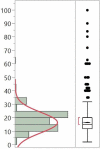Opioid Prescribing in a Cross Section of US Emergency Departments
- PMID: 25952503
- PMCID: PMC4550521
- DOI: 10.1016/j.annemergmed.2015.03.026
Opioid Prescribing in a Cross Section of US Emergency Departments
Abstract
Study objective: Opioid pain reliever prescribing at emergency department (ED) discharge has increased in the past decade but specific prescription details are lacking. Previous ED opioid pain reliever prescribing estimates relied on national survey extrapolation or prescription databases. The main goal of this study is to use a research consortium to analyze the characteristics of patients and opioid prescriptions, using a national sample of ED patients. We also aim to examine the indications for opioid pain reliever prescribing, characteristics of opioids prescribed both in the ED and at discharge, and characteristics of patients who received opioid pain relievers compared with those who did not.
Methods: This observational, multicenter, retrospective, cohort study assessed opioid pain reliever prescribing to consecutive patients presenting to the consortium EDs during 1 week in October 2012. The consortium study sites consisted of 19 EDs representing 1.4 million annual visits, varied geographically, and were predominantly academic centers. Medical records of all patients aged 18 to 90 years and discharged with an opioid pain reliever (excluding tramadol) were individually abstracted by standardized chart review by investigators for detailed analysis. Descriptive statistics were generated.
Results: During the study week, 27,516 patient visits were evaluated in the consortium EDs; 19,321 patients (70.2%) were discharged and 3,284 (11.9% of all patients and 17.0% of discharged patients) received an opioid pain reliever prescription. For patients prescribed an opioid pain reliever, mean age was 41 years (SD 14 years) and 1,694 (51.6%) were women. Mean initial pain score was 7.7 (SD 2.4). The most common diagnoses associated with opioid pain reliever prescribing were back pain (10.2%), abdominal pain (10.1%), and extremity fracture (7.1%) or sprain (6.5%). The most common opioid pain relievers prescribed were oxycodone (52.3%), hydrocodone (40.9%), and codeine (4.8%). Greater than 99% of pain relievers were immediate release and 90.0% were combination preparations, and the mean and median number of pills was 16.6 (SD 7.6) and 15 (interquartile range 12 to 20), respectively.
Conclusion: In a study of ED patients treated during a single week across the country, 17% of discharged patients were prescribed opioid pain relievers. The majority of the prescriptions had small pill counts and almost exclusively immediate-release formulations.
Copyright © 2015 American College of Emergency Physicians. Published by Elsevier Inc. All rights reserved.
Figures
Similar articles
-
Changes in Provider Prescribing Patterns After Implementation of an Emergency Department Prescription Opioid Policy.J Emerg Med. 2017 Apr;52(4):538-546. doi: 10.1016/j.jemermed.2016.07.120. Epub 2017 Jan 19. J Emerg Med. 2017. PMID: 28111065
-
Rising opioid prescribing in adult U.S. emergency department visits: 2001-2010.Acad Emerg Med. 2014 Mar;21(3):236-43. doi: 10.1111/acem.12328. Acad Emerg Med. 2014. PMID: 24628748
-
Prescription of opioid analgesics for nontraumatic dental conditions in emergency departments.Drug Alcohol Depend. 2015 Nov 1;156:261-266. doi: 10.1016/j.drugalcdep.2015.09.023. Epub 2015 Sep 28. Drug Alcohol Depend. 2015. PMID: 26471416 Free PMC article.
-
The Contribution of the Emergency Department To Opioid Pain Reliever Misuse And Diversion: A Critical Review.Pain Pract. 2017 Nov;17(8):1097-1104. doi: 10.1111/papr.12568. Epub 2017 Mar 20. Pain Pract. 2017. PMID: 28226416 Review.
-
Evaluation of Interventions to Reduce Opioid Prescribing for Patients Discharged From the Emergency Department: A Systematic Review and Meta-analysis.JAMA Netw Open. 2022 Jan 4;5(1):e2143425. doi: 10.1001/jamanetworkopen.2021.43425. JAMA Netw Open. 2022. PMID: 35024834 Free PMC article.
Cited by
-
Epidemiology of paediatric pain-related visits to emergency departments in the USA: a cross-sectional study.BMJ Open. 2021 Aug 16;11(8):e046497. doi: 10.1136/bmjopen-2020-046497. BMJ Open. 2021. PMID: 34400448 Free PMC article.
-
A Review of Current and Emerging Approaches to Pain Management in the Emergency Department.Pain Ther. 2017 Dec;6(2):193-202. doi: 10.1007/s40122-017-0090-5. Epub 2017 Nov 10. Pain Ther. 2017. PMID: 29127600 Free PMC article. Review.
-
Acceptability, Adaptation, and Clinical Outcomes of Acupuncture Provided in the Emergency Department: A Retrospective Pilot Study.Pain Med. 2017 Jan 30;18(1):169-178. doi: 10.1093/pm/pnv114. Pain Med. 2017. PMID: 26917627 Free PMC article.
-
Opioid-related overdose and chronic use following an initial prescription of hydrocodone versus oxycodone.PLoS One. 2022 Apr 5;17(4):e0266561. doi: 10.1371/journal.pone.0266561. eCollection 2022. PLoS One. 2022. PMID: 35381052 Free PMC article.
-
A Randomized Trial Testing the Effect of Narrative Vignettes Versus Guideline Summaries on Provider Response to a Professional Organization Clinical Policy for Safe Opioid Prescribing.Ann Emerg Med. 2016 Dec;68(6):719-728. doi: 10.1016/j.annemergmed.2016.03.007. Epub 2016 Apr 29. Ann Emerg Med. 2016. PMID: 27133392 Free PMC article. Clinical Trial.
References
-
- Cordell WH, Keene KK, Giles BK, Jones JB, Jones JH, Brizendine EJ. The high prevalence of pain in emergency medical care. Am J Emerg Med. 2002 May;20(3):165–9. - PubMed
-
- Todd KH, Ducharme J, Choiniere M, Crandall CS, Fosnocht DE, Homel P, Tanabe P. PEMI Study Group. Pain in the emergency department: results of the pain and emergency medicine initiative (PEMI) multicenter study. J Pain. 2007 Jun;8(6):460–6. - PubMed
-
- Schappert SM, Rechtsteiner EA. Ambulatory medical care utilization estimates for 2007. Vital Health Stat. 2011 Apr;13(169):1–38. - PubMed
-
- Centers for Disease Control and Prevention (CDC) CDC grand rounds: prescription drug overdoses - a U.S. epidemic. MMWR Morb Mortal Wkly Rep. 2012 Jan 13;61(1):10–3. - PubMed
-
- Cantrill SV, Brown MD, Carlisle RJ, Delaney KA, Hays DP, Nelson LS, O'Connor RE, Papa A, Sporer KA, Todd KH, Whitson RR. American College of Emergency Physicians Opioid Guideline Writing Panel. Clinical policy: critical issues in the prescribing of opioids for adult patients in the emergency department. Ann Emerg Med. 2012 Oct;60(4):499–525. - PubMed
Publication types
MeSH terms
Substances
Grants and funding
LinkOut - more resources
Full Text Sources
Other Literature Sources
Miscellaneous


